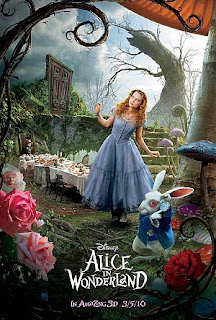Alice in Wonderland
 From the first notes of the Danny Elfman score, with the voices of the spooky children's choir, my heart sank a little, for it was clear that this adaptation of Alice in Wonderland was going to be less about Lewis Carroll than it would be about Tim Burton. There have been dozens of film and stage adaptations of Carroll's enchanting stories in the years since their publication, and almost all of them have been reflected through the prism of their adaptor. In the case of Burton, though, this means little other than dead, curlicued tree branches and allowing Johnny Depp to run wild.
From the first notes of the Danny Elfman score, with the voices of the spooky children's choir, my heart sank a little, for it was clear that this adaptation of Alice in Wonderland was going to be less about Lewis Carroll than it would be about Tim Burton. There have been dozens of film and stage adaptations of Carroll's enchanting stories in the years since their publication, and almost all of them have been reflected through the prism of their adaptor. In the case of Burton, though, this means little other than dead, curlicued tree branches and allowing Johnny Depp to run wild.I've admired many Burton films over the years, including some that were reviled by many, such as Charlie and the Chocolate Factory. But it turns out that Burton and Carroll don't mix, especially when the script, by Linda Woolverton, is an assault upon the original. What they have chose to do is make a sequel of sorts to the originals: Alice's Adventures in Wonderland and Through the Looking Glass. Alice, now nineteen, is on the cusp of adulthood and is courted by a weak-chinned twit with a horrible mother who proposes to her in front of an assembled gathering of guests. She asks everyone for a moment and chases the white rabbit, and ends falling down a hole. She had already been there, when she was six, but has no memory of it, but the creatures in Wonderland (or "Underland," as they call it) remember her, and hope that she can be their champion and overthrow the evil rule of the Red Queen.
Now, it's not a sin to have to apply twenty-first century screenplay rules to Carroll's episodic tales, which defy a strict adaptation. But it's another to completely lose sight of what made the originals so charming and instead cherry-pick characters and lines (some of them spoken by the wrong characters) into a plot that is a mash-up of The Wizard of Oz and The Chronicles of Narnia. Burton and Woolverton have jettisoned many characters (no Mock Turtle, Humpty Dumpty, or White Knight) and focused on the Mad Hatter (played without discipline by Depp), the macrocephalic Red Queen (Helena Bonham Carter), the Caterpillar, the Cheshire Cat and the White Queen, standing in for Glinda the Good Witch, played by Anne Hathaway. Carroll fanciers such as myself will be either stewing or bemoaning or a combination of the two as the wit of the originals are squeezed out like so much pulp.
But what if someone stumbled into the theater with no knowledge of the original books--what to make of the film completely standing alone? Not much. The plot, as it were, is very thin--Alice meanders among the various characters as those for good, led by the Hatter, hope that she will take arms against the Red Queen's dragon-like Jabberwocky, and thus defeating him will restore the White Queen to the throne. While all of this is going on, though, there's little suspense or much understanding of why any character is doing anything at all. And while I'm discussing the Jabberwocky, why is it that it is called the Jabberwocky, when in the book it is called the Jabberwock (the name of the poem is called "Jabberwocky"). This is a pretty sloppy mistake.
Instead of the magic of Carroll's puns and riddles, we get Burton's obligatory art direction and a modern, mushy application of psychology. This is not new, of course. Way back in 1932 G.K. Chesterton wrote, "Poor, poor little Alice! She has not only been caught and made to do lessons; she has been forced to inflict lessons on others." Now that we're in the Dr. Phil era we get an Alice that is all about grrl-power; it seems that she fell down that hole to get the courage to reject a marriage proposal and suggest that Britain trade with China.
There's very little to admire about the film. The acting is all over the map. Mia Wasikowska makes a bland Alice, and as mentioned Depp is out of control. Carter has fun with the Red Queen, and several recognizable voices (Alan Rickman, Stephen Fry, Timothy Spall, Christopher Lee, Michael Gough) pop up as CGI'ed characters. As for the CGI, some of it works, but some of it doesn't--why is Crispin Glover, who plays the Knave of Hearts, given a CGI body and horse to ride? The photography, by Dariusz Wolski, makes great use of color, but it doesn't fit the material, instead reiterating Burton's palette from his entire career.
Fortunately, the books remain vivid. I went home and pulled my copy of The Annotated Alice off the shelf, with notes by Martin Gardner, to remind myself of why this story has been pulled at and messed with ever since its publication in 1865. It will long outlast this woe-begone adaptation.


Comments
Post a Comment